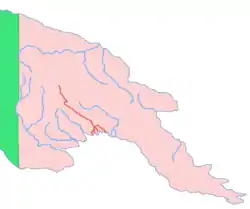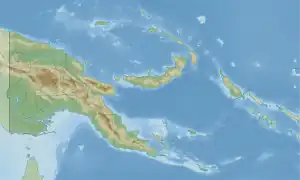| Kikori | |
|---|---|
 | |
 | |
| Physical characteristics | |
| Source | Southern Highlands |
| • location | Confluence of Hegigio and Mubi |
| • coordinates | 6°47′33″S 143°36′55″E / 6.79250°S 143.61528°E |
| • elevation | 52 m (171 ft) |
| Mouth | Gulf of Papua |
• location | Kikori Delta, Papua New Guinea |
• coordinates | 7°43′00″S 144°16′46″E / 7.71667°S 144.27944°E |
• elevation | 0 ft (0 m) |
| Length | 445 km (277 mi) |
| Basin size | 23,309 km2 (9,000 sq mi) |
| Discharge | |
| • location | Kikori Delta, Gulf of Papua |
| • average | 3,274 m3/s (115,600 cu ft/s)[1] |
| Discharge | |
| • location | Kaiam, West Kikori Rural LLG |
| • average | 2,571 m3/s (90,800 cu ft/s)[2] |
| • minimum | 670 m3/s (24,000 cu ft/s)[2] |
| • maximum | 4,414 m3/s (155,900 cu ft/s)[2] |
| Basin features | |
| Tributaries | |
| • left | Mubi, Sirebi |
| • right | Hegigio |
The Kikori River is a major river in southern Papua New Guinea on the island of New Guinea. The river has a total length of 445 km (277 mi) and flows southeast into the Gulf of Papua, with its delta at the head of the gulf. The settlement of Kikori lies on the delta.[3]
Geography
The catchment area extends from alpine grasslands of the Southern Highlands to mangrove wetlands of the mouth at Papua Gulf. The Kikori arises at the confluence of the Hegigio with the Mubi (river) or Digimu, into which Lake Kutubu drained. The average rainfall in the Kikori catchment is 5,900 millimetres or 230 inches.
The city of the same name is located on the right bank just before its confluence with the delta.
Economy
The Kikori river basin is home to large oil and gas fields that have been mined since the 1990s. A pipeline for oil and gas transport ( Papua New Guinea LNG Project) runs in the Kikori River system from Lake Kutubu over to Papua Gulf.
Biodiversity
The Kikori river system is known for its biodiversity. Mount Bosavi, which is well known in this respect, lies on the western edge of the Kikori river basin. The catchment area of the Kikori includes more than 100 species of fish, of which 14 percent are endemic; along with the western, and much longer Fly River, it is the most species-rich river in New Guinea. However, most of the endemic fish do not live in the rivers, but in Lake Kutubu. Furthermore, in the Kikori Basin there are three species of cherax, an endemic blind cavern Oxyeleotris caeca and six species of freshwater turtles.[4]
See also
References
- ↑ Christer, Nilsson; Catherine, Reidy, Liermann; Mats, Dynesius; Carmen, Revenga (2005). "Fragmentation and Flow Regulation of the World's Large River System". doi:10.1126/science.1107887.
{{cite web}}: CS1 maint: multiple names: authors list (link) - 1 2 3 "Receiving Onshore Environment: Upstream Facilities and Onshore Pipelines" (PDF).
- ↑
- Merriam Webster's Geographical Dictionary, Third Edition. Springfield, Massachusetts: Merriam-Webster, Incorporated, 1997. ISBN 0-87779-546-0 p. 592.
- ↑ Richards, S.J. (Editor) Rapid biological assessments of Wau Creek, Uro Creek and Lake Kutubu: documenting biodiversity values to promote forest conservation in the Kikori River basin, Papua New Guinea. ExxonMobil PNG Limited. Port Moresby. 2018 ISBN 978-0-6484933-1-0
External links